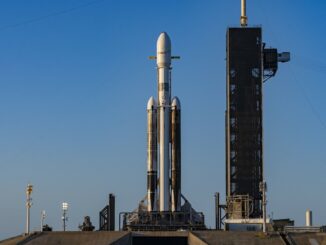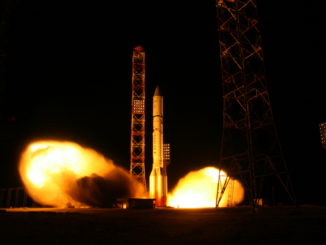STORY WRITTEN FOR CBS NEWS & USED WITH PERMISSION
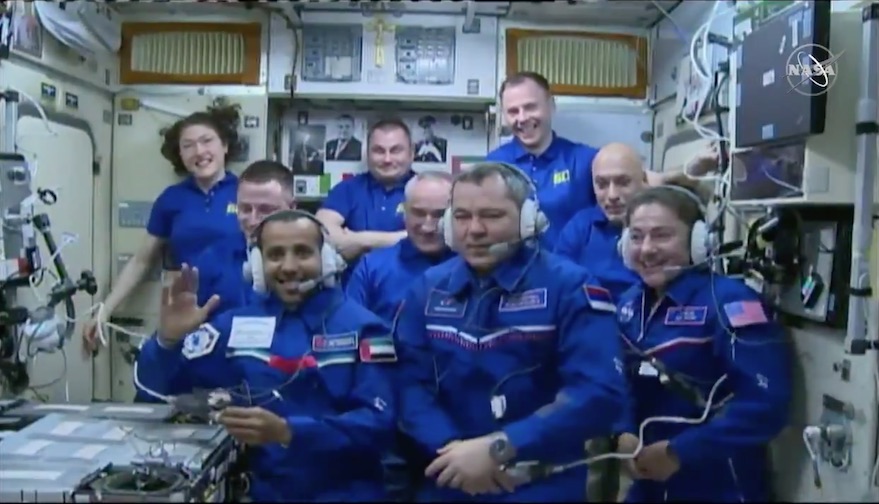
A Soyuz rocket carrying a Russian commander, a NASA co-pilot and a United Arab Emirates guest cosmonaut blasted off from Kazakhstan Wednesday, chased down the International Space Station and glided in for a picture-perfect docking, kicking off an unprecedented end-of-year schedule that includes up to a dozen spacewalks.
With Soyuz MS-15/61S commander Oleg Skripochka at the controls, flanked on the left by flight engineer Jessica Meir and on the right by Hazzaa Ali Almansoori, the Soyuz-FG rocket roared to life and climbed away at 9:57:43 a.m. EDT (6:57 p.m. local time), the moment Earth’s rotation carried the pad into the plane of the station’s orbit.
The launching came one day after the Japanese space agency launched an unpiloted HTV cargo ship toward the station carrying a set of replacement batteries for the lab’s solar power system and equipment to help repair a $2 billion cosmic ray detector.
After a problem-free climb to space, Skripochka and Meir monitored a four-orbit rendezvous with the space station, moving in for docking at the aft port of the Russian Zvezda module at 3:42 p.m.
Standing by to welcome their new crewmates aboard were Expedition 60 commander Alexey Ovchinin, fellow cosmonaut Alexander Skvortsov, European Space Agency astronaut Luca Parmitano and NASA astronauts Nick Hague, Christina Koch and Drew Morgan. The first major item on the expanded crew’s agenda is arrival of the HTV cargo ship Saturday morning.
Five spacewalks are planned next month to replace 12 aging batteries with six more powerful lithium-ion power packs carried up in the HTV’s cargo bay.
Another half dozen EVAs are planned in November and December to repair the Alpha Magnetic Spectrometer, an unprecedented sequence that will come amid ongoing cargo delivery missions, a full slate of on-board research, a Russian spacewalk and possible visits by commercial crew ships being built by Boeing and SpaceX.
Meir, who holds a private pilot’s license and a doctorate in marine biology, served as Skripochka’s co-pilot in the Soyuz’s cramped cockpit, trained to take over in an emergency and fly the spacecraft if needed. She’s also received spacewalk training and hopes to venture outside the station at some point during her stay.
Skripochka is making his third trip to the station and is expected to participate in a Russian spacewalk in November. He is a veteran of three previous EVAs.
“He’s a great guy,” Meir said. “He’s an experienced cosmonaut, so he brings a lot of knowledge and experience to the table for us. It’s my first spaceflight and Hazzaa Ali Almansoori, the very first astronaut from the United Arab Emirates, is also brand new, he’s only been training as an astronaut for a year. So we often look to Oleg for advice.”
Almansoori is the tenth “Spaceflight Participant” to visit the lab complex and the first since Cirque du Soleil’s Guy Laliberte in 2009.
“This mission is a great milestone, for me personally and for my country, the United Arab Emirates, and for the whole Arab region in general,” Almansoori said in a preflight briefing. “I’m looking forward to joining the crew on the station and to work with them on a daily basis and to conduct experiments. I’m looking forward to coming back with knowledge and experience to share with everyone.”
A jet fighter pilot, Almansoori is sponsored by the UAE government. But as with earlier “space tourists,” he will enjoy a relatively short stay in orbit — eight days — before returning to Earth Oct. 3 with Ovchinin and Hague, who are wrapping up a 202-day mission.
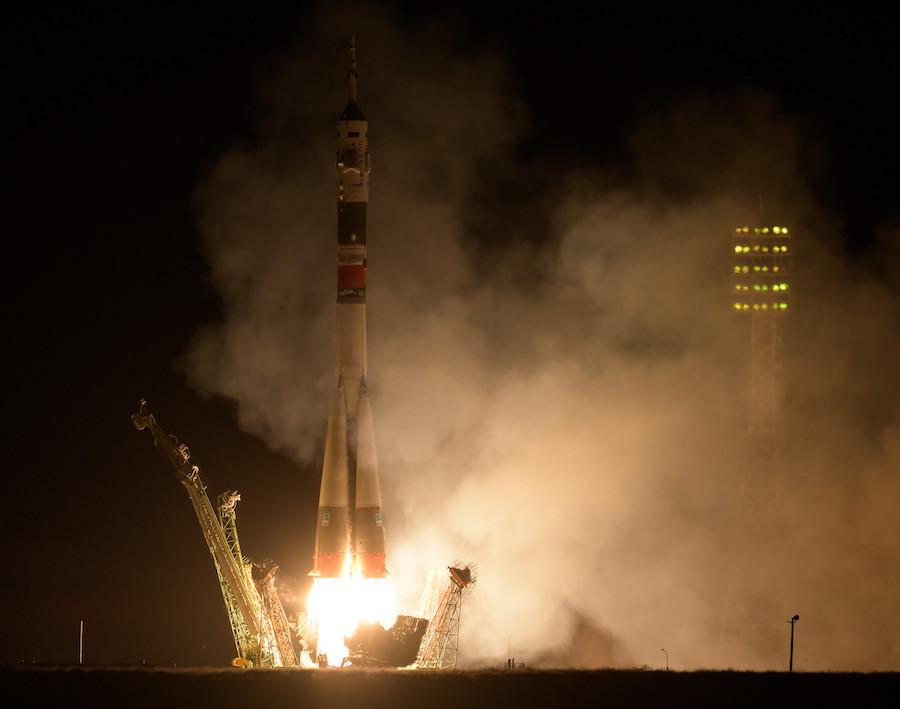
Ovchinin, Hague and Koch took off aboard the Soyuz MS-12/58S spacecraft on March 14. Koch’s stay aboard the station has been extended to February and she will join Skvortsov and Parmitano for the ride home aboard their Soyuz MS-13/59S spacecraft after nearly a year — 328 days — in space.
Koch will set a new record for longest single flight by a female astronaut on Dec. 28, moving past Peggy Whitson’s mark of 289 days.
Almansoori will take Koch’s seat aboard the MS-12/58S ferry ship coming down on Oct. 3. Morgan, who launched with Skvortsov and Parmitano on July 20, will join Skripochka and Meir when they return to Earth next April. His flight will span 255 days.
The Soyuz launching Wednesday, along with Japan’s launch of an HTV cargo ship Tuesday (U.S. time), kicks off one of the most challenging station schedules ever attempted with up to 11 U.S. spacewalks planned between now and the end of the year and a Russian EVA in November.
Along with the HTV-8 arrival Saturday, the crew expects to welcome three more cargo ships and, possibly, Boeing’s CST-100 Starliner crew ferry ship if NASA clears it for launch before the end of the year on a long-awaited unpiloted test flight.
Boeing and SpaceX are both building commercial crew ferry ships to end NASA’s sole reliance on the Soyuz. But the program has suffered a series of funding shortfalls and technical problems, and it’s not yet clear when either company will be clear to launch astronaut crews on initial test flights.
It’s a critical issue for NASA because the Russians only plan to launch two Soyuz spacecraft next year, one in March and the other in October. In the absence of an American ferry ship, the station crew will drop from six to three next April when Skripochka, Meir and Morgan return to Earth.
SpaceX’s first piloted test flight, known as Demo-2, is on hold following an explosion during a ground test in April that destroyed an earlier vehicle. The Demo-2 mission, whenever it eventually flies, will carry two NASA astronauts to the station for an eight-day mission.
Boeing’s first piloted test flight, a mission known as CFT, will last a full six months, and that is the flight NASA is counting on to keep the station fully staffed until one or both companies begin operational crew rotation flights.
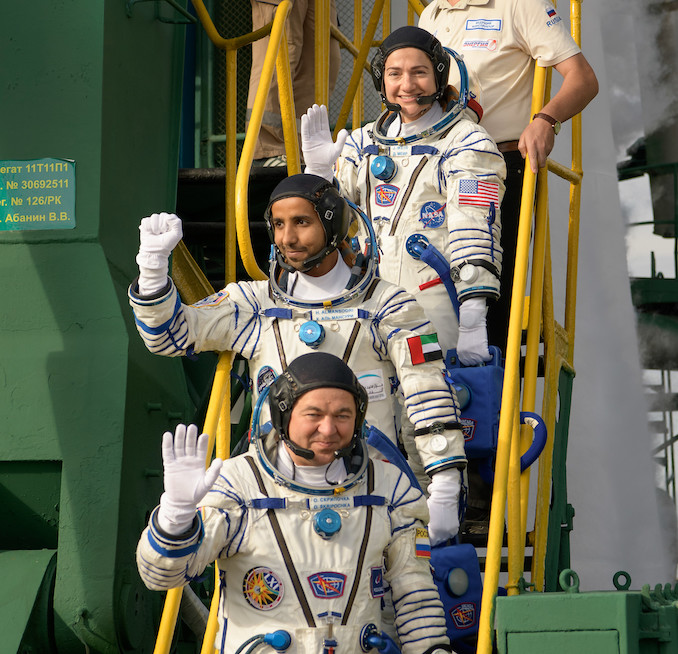
“A lot of the commercial crew dates have been a little bit in flux lately,” Meir said. “But it does look like we should be seeing the (unpiloted) Boeing flight, I think that will happen during our mission, and I’ve been receiving training on the ground to help make sure that that mission is successful.
“We do also, of course, hope we see some of the first commercial crew astronauts during our mission. That would be excellent. … The key is being flexible and being able to adapt. That’s something our training really allows us to do. We’ll be ready for any scenario.”
The upcoming spacewalks pose the most significant near-term challenge with five needed to install the batteries brought up aboard the HTV-8 spacecraft and up to a half dozen needed to repair the Alpha Magnetic Spectrometer, a high-priority particle physics experiment mounted on the station’s power truss.
The AMS instrument was not designed to be repaired by spacewalking astronauts and NASA planners say the EVAs needed to fix a failing pump and carry out other upgrades represent the most complex spacewalks since repairs of the Hubble Space Telescope. The AMS EVAs will be carried out by Parmitano and Morgan.
The battery installation work is not as technically complex, but it poses additional challenges, requiring spacewalkers to work near the limit of the robot arm’s reach on the far left end of the station’s solar power truss. NASA has not yet named the astronauts who will carry out the battery work, but Meir, Koch and Morgan have all been trained.
“I’m really looking forward to the potential to do a spacewalk, since that’s really what I’ve always envisioned myself doing, really, my whole life,” Meir said.
The station’s power truss stretches the length of a football field and features eight huge solar wings, four on each end arranged in pairs. The arrays rotate like slow-motion paddle wheels as the station flies through its orbit to maximize the amount of sunlight reaching the solar cells.
When the station is in sunlight, power is fed directly to the lab’s myriad electrical systems. At the same time, they re-charge four sets of massive batteries housed at the base of each set of arrays. When the station moves into orbital darkness, the batteries seamlessly kick in to keep the station powered.
The station’s eight electrical power channels originally were supported by 48 nickel-hydrogen — NiH2 — batteries, six per channel. Twenty-four batteries, in two sets of 12, were mounted at the bases of the solar array wings on the starboard, or right, side of the station’s main truss with two sets of 12 on the port, or left, side.
But the original batteries have lost strength over the years and NASA is in the process of replacing all four sets with 24 smaller, more efficient lithium-ion — Li-Ion — batteries. The replacement units pack twice the punch, so only six are needed per set.
The HTV-6 cargo ship delivered the first set of replacements in December 2016. They were installed on the starboard 4, or S4, solar array segment during two spacewalks in January 2017. NASA installed a second set, delivered by the HTV-7 cargo ship, last September on the port 4, or P4 arrays.
The third set, launched Tuesday, will be installed on the far left end, or port 6, segment of the power truss.
Assuming the work goes smoothly, NASA managers hope to begin the AMS repair work in early to mid November. Five to six spacewalks may be necessary.
The $2 billion Alpha Magnetic Spectrometer, a project led by Nobel laureate Samuel Ting, was designed to detect high energy cosmic rays and measure any antimatter that might be present to learn more about dark matter, dark energy and by extension, the evolution of the cosmos. The instrument was carried up on the next-to-last shuttle mission and installed in May 2011
“It’s a pretty incredible piece of machinery, it’s actually measuring high energy radiation, cosmic rays coming from different stars, it is looking for evidence of antimatter and dark matter to begin to answer more questions about the origin of our universe,” Meir said.
“Unfortunately, one of the pumps that’s vital to the thermal control system of that instrument is broken. Well, it’s not broken yet, but it is degrading. And so we’re going to do a series of spacewalks during the mission in order to fix that pump. … It wasn’t designed to be fixed (in space).”
That makes the work “kind of like the Hubble Space Telescope scenario where you didn’t actually design tools for it or interfaces for it,” Meir said. “So it’s a very complex and challenging spacewalk, and we’re very excited to conduct that during our mission.”

